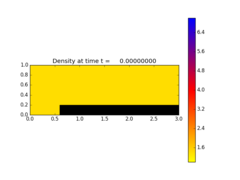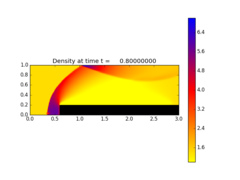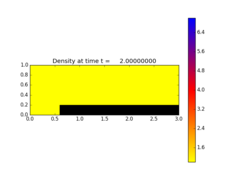2-dimensional Euler equations¶
Compressible Euler flow over a forward-facing step¶
Solve the Euler equations of compressible fluid dynamics in 2D:
\[\begin{split}\rho_t + (\rho u)_x + (\rho v)_y = 0 \\
(\rho u)_t + (\rho u^2 + p)_x + (\rho uv)_y = 0 \\
(\rho v)_t + (\rho uv)_x + (\rho v^2 + p)_y = 0 \\
E_t + (u (E + p) )_x + (v (E + p))_y = 0.\end{split}\]
Here \(\rho\) is the density, (u,v) is the velocity, and E is the total energy.
The problem involves a shock wave impacting a forward-facing step. A stationary shock forms. When using a Roe solver, there is a carbuncle instability.
This example demonstrates how to include internal boundaries within the domain. An aux array field is used to indicate which cells are inside (1) or outside (0) of the domain. A special Riemann solver enforces reflecting boundary conditions at the internal boundaries. This could be modified to handle other internal boundary geometries, as long as they are aligned with the grid.
Source:¶
#!/usr/bin/env python
# encoding: utf-8
r"""
Compressible Euler flow over a forward-facing step
==================================================
Solve the Euler equations of compressible fluid dynamics in 2D:
.. math::
\rho_t + (\rho u)_x + (\rho v)_y = 0 \\
(\rho u)_t + (\rho u^2 + p)_x + (\rho uv)_y = 0 \\
(\rho v)_t + (\rho uv)_x + (\rho v^2 + p)_y = 0 \\
E_t + (u (E + p) )_x + (v (E + p))_y = 0.
Here :math:`\rho` is the density, (u,v) is the velocity, and E is the total energy.
The problem involves a shock wave impacting a forward-facing step. A
stationary shock forms. When using a Roe solver, there is a carbuncle
instability.
This example demonstrates how to include internal boundaries within the
domain. An aux array field is used to indicate which cells are inside (1)
or outside (0) of the domain. A special Riemann solver enforces reflecting
boundary conditions at the internal boundaries. This could be modified
to handle other internal boundary geometries, as long as they are
aligned with the grid.
"""
from __future__ import absolute_import
from six.moves import range
gamma = 1.4 # Ratio of specific heats
def incoming_shock(state,dim,t,qbc,auxbc,num_ghost):
"""
Incoming shock at left boundary.
"""
rho = 1.4
u = 3.0
v = 0.0
p = 1.0
T = 2*p/rho
for i in range(num_ghost):
qbc[0,i,...] = rho
qbc[1,i,...] = rho*u
qbc[2,i,...] = rho*v
qbc[3,i,...] = rho*(5.0/4 * T + (u**2+v**2)/2.)
def setup(use_petsc=False,solver_type='classic', outdir='_output', kernel_language='Fortran',
disable_output=False, mx=320, my=80, tfinal=2.0, num_output_times = 10):
if use_petsc:
import clawpack.petclaw as pyclaw
else:
from clawpack import pyclaw
from clawpack import riemann
if solver_type=='sharpclaw':
#solver = pyclaw.SharpClawSolver2D(euler_with_boundaries)
raise Exception('This problem does not currently work with SharpClaw')
else:
solver = pyclaw.ClawSolver2D(riemann.euler_hlle_with_walls_2D)
solver.dimensional_split = True
solver.num_eqn = 4
solver.num_waves = 4
num_aux = 1
x = pyclaw.Dimension(0.0,3.0,mx,name='x')
y = pyclaw.Dimension(0.0,1.0,my,name='y')
domain = pyclaw.Domain([x,y])
state = pyclaw.State(domain,solver.num_eqn,num_aux)
state.problem_data['gamma']= gamma
solver.user_bc_lower = incoming_shock
solver.bc_lower[0]=pyclaw.BC.custom
solver.bc_upper[0]=pyclaw.BC.extrap
solver.bc_lower[1]=pyclaw.BC.wall
solver.bc_upper[1]=pyclaw.BC.wall
solver.aux_bc_lower[0]=pyclaw.BC.extrap
solver.aux_bc_upper[0]=pyclaw.BC.extrap
solver.aux_bc_lower[1]=pyclaw.BC.wall
solver.aux_bc_upper[1]=pyclaw.BC.wall
rho = 1.4
u = 3.0
v = 0.
p = 1.0
T = 2*p/rho
state.q[0,...] = rho
state.q[1,...] = rho*u
state.q[2,...] = rho*v
state.q[3,...] = rho*(5.0/4 * T + (u**2+v**2)/2.)
x,y = domain.grid.p_centers
# Set aux values to zero inside step, to unity elsewhere
state.aux[0,...]= 1 - (x > 0.6)*(y < 0.2)
claw = pyclaw.Controller()
claw.solution = pyclaw.Solution(state,domain)
claw.solver = solver
claw.keep_copy = True
if disable_output:
claw.output_format = None
claw.tfinal = tfinal
claw.num_output_times = num_output_times
claw.outdir = outdir
claw.setplot = setplot
return claw
def setplot(plotdata):
"Plot solution using VisClaw."
from clawpack.visclaw import colormaps
plotdata.clearfigures() # clear any old figures,axes,items data
# Density plot
plotfigure = plotdata.new_plotfigure(name='Density', figno=0)
plotaxes = plotfigure.new_plotaxes()
plotaxes.title = 'Density'
plotaxes.scaled = True # so aspect ratio is 1
plotaxes.afteraxes = fill_step
plotitem = plotaxes.new_plotitem(plot_type='2d_pcolor')
plotitem.plot_var = 0
plotitem.pcolor_cmin = 1
plotitem.pcolor_cmax = 7.0
plotitem.add_colorbar = True
# Schlieren plot of density
plotfigure = plotdata.new_plotfigure(name='Schlieren', figno=1)
plotaxes = plotfigure.new_plotaxes()
plotaxes.title = 'Density (Schlieren)'
plotaxes.scaled = True # so aspect ratio is 1
plotaxes.afteraxes = fill_step
plotitem = plotaxes.new_plotitem(plot_type='2d_schlieren')
plotitem.schlieren_cmin = 0.
plotitem.schlieren_cmax = 3.
plotitem.plot_var = 0
plotitem.add_colorbar = False
return plotdata
def fill_step(_):
"Fill the step area with a black rectangle."
import matplotlib.pyplot as plt
rectangle = plt.Rectangle((0.6,0.0),2.4,0.2,color="k",fill=True)
plt.gca().add_patch(rectangle)
if __name__=="__main__":
from clawpack.pyclaw.util import run_app_from_main
output = run_app_from_main(setup,setplot)



